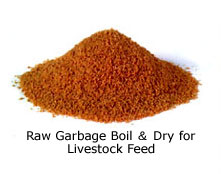|
|

Raw Garbage Boil & Dry for Livestock Feed Plant
|



Now it is time to process raw garbage into livestock feed.
|
In May 2001, food recycling laws were passed which enforce the recycling of waste food as resources. Many companies are pushing forward to try and build fermenting apparatus for fertilizer production. However, they have had to face a lot of problems, specially regarding hygiene, quality and usage. As the situation stands, the Okadora Cyclone Dryer and the Raw Garbage Boil & Dry Plant have proven to be the only method of achieving the target without problems. Okadora-processed end products are high in quality, safety, and they have well established distribution channels.
|
|
 |
List of Analysis
|
Water
|
8.9%
|
Crude Protein
|
32%
|
Crude Fat
|
6.5%
|
Crude Fiber
|
1.8%
|
Crude Ashes
|
5.7%
|
Calorie(Measured by pump Calorie meter)
|
432kcal/100g
|
Phosphorous
|
524mg/100g
|
Calcium
|
328mg/100g
|
Salt(as NACL,Na conversion Figure)
|
1.59%
|
Colon Bacillus
|
Negative
|
Salmonella
|
Negative
|
|
|
Comparison Table for Raw Garbage Livestock Feed Production Plant
|
System
|
Okadora Boil & Dry System
|
Wet Method Plant
(Fish Meal Type)
|
Dry Method Plant
(Tempura Type)
|
|
|
|
Plant Space
(Building)
|
Compact design means less space
(330 m2)
|
Large space needed
(1,000 m2)
|
Not as much space as the Wet Method but still a lot of space required
(830 m2)
|
Construction Cost
|
10,000,000~20,000,000
JPY/ton/month
|
40,000,000~50,000,000
JPY/ton/month
|
12,000~20,000
JPY/ton
|
Running Cost
|
5,000~4,000 JPY/ton
|
15,000~18,000 JPY/ton
|
12,000~20,000 JPY/ton
|
Operation/
Originality
|
Compact for installation anywhere and simple operating system.
Treatment of all kinds of ingredients
|
Difficult to maintain.
Better to use when a high-value product is required.
|
Difficult to maintain.
Suitable only for treatment of a few animal wastes.
|
Additives
|
None
|
None
|
A lot of topping-up oil is required to improve dehydration.
|
Quality of Livestock Feed
|
Good
|
Good
|
Residual fat reduced to 10% but a lot of oxidized oil remains, causing a degraded quality and strong smell.
|
Waste Water
|
Non
|
A large amount
|
Not much but difficult to treat and needs high- tech apparatus for water treatment.
|
Wasted Material
|
None
|
None
|
A lot of additives (oxidized oil) are produced.
|
Smell
|
None
|
Substantial
|
Substantial
|
|
|




